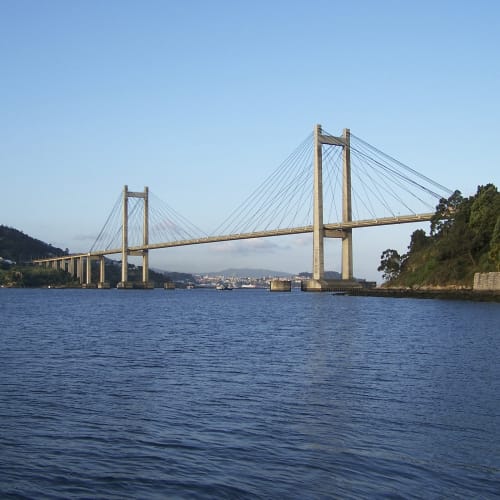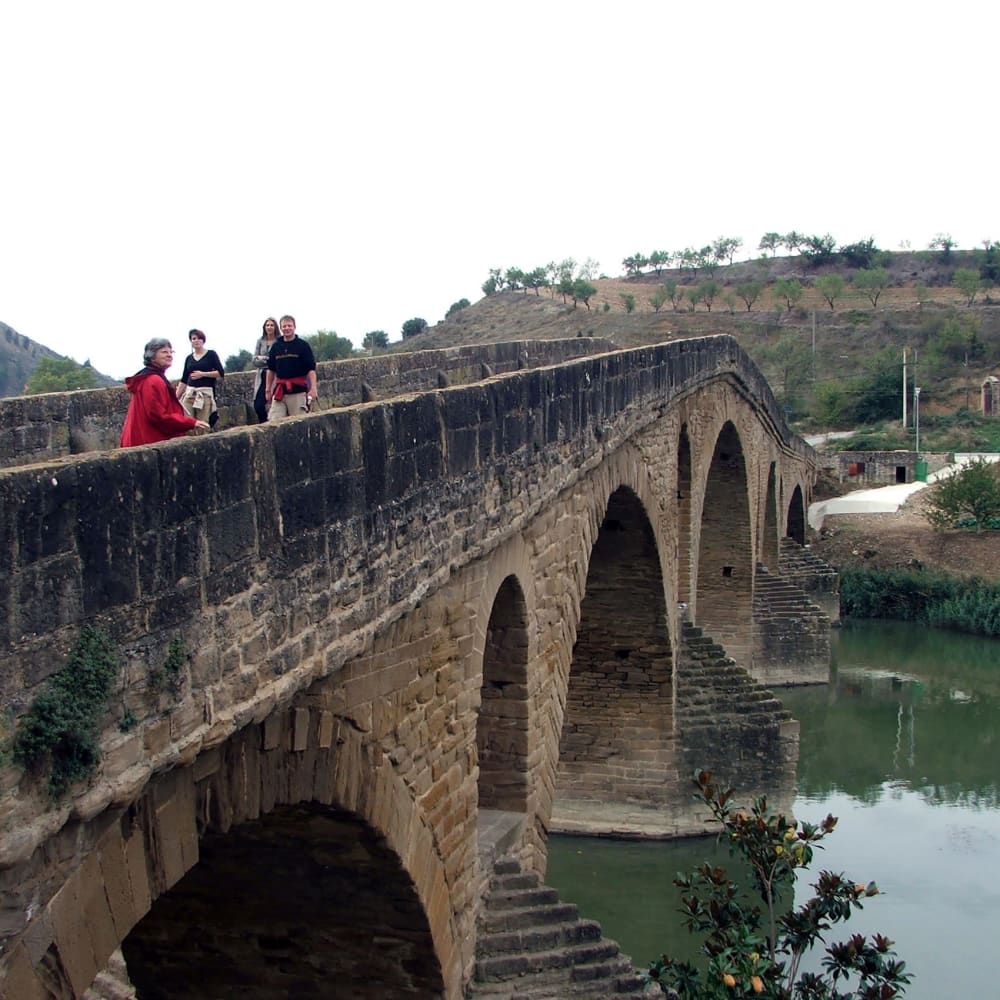Bridging Old and New in Spain
August 2005




Three of my most lasting images of Spain involve bridges. One involves the bridge at Ciudad Rodrigo, an active rural center with a long history, in Salamanca province close to the Portuguese border.
My wife Ruth and I stayed in a wonderful restored 14th C castle - part of the national Parador system. As we stood by the open window of our room that day many years ago we could see women washing clothes along the Aguedo river bank as they had been doing for centuries and beyond the women was a beautifully proportioned bridge built by the Romans more than two thousand years ago.
The bridge, the river running through the city, the women by the river bank - it was a timeless image - it could have been from any century except when the scene was disturbed by a random truck heading over the bridge toward Portugal. We returned to Ciudad Rodrigo two years ago to enjoy a local festival. The castle, the Roman bridge, and the vistas were there, but the women washing their clothes on the rocks by the river were not. The timeless touristic scene had been altered.
This is one of the paradoxes of being an American tourist in Spain. On the one hand we like to immerse ourselves in ages past -- largely because our American culture is so new. In this case the city dates back to dolmens in pre-history and extends to Romans, Suevians, Visigoths, Moors, Christians. On the other hand, we surely do not want to sentence the local Rodrigan housewives to hand washing clothes at the river in order to enhance our enjoyment of the past. A washing machine is a good thing!
Another bridge whose image has lodged itself in my memory is a medieval bridge with eight stone arches which spans the Arga River in Aragón. It was built by queen Doña Mayor a little after the beginning of the last millennium in order to help the streams of pilgrims who were on their way to Santiago de Compostela. The bridge was at the juncture of two major pilgrimage routes that stretched back to France and Holland and the town which formed in the vicinity of the bridge was named Puente de la Reina - literally the Bridge of the Queen. It is a fascinating place where you can enjoy many religious monuments contributed by the medieval pilgrims. One of the most moving is a cross in the wayside chapel 'El Crucifijo', carved by a German pilgrim centuries ago.
Today the byway is still crowded with travelers along the Camino de Santiago. Some of them are pilgrims in the old-fashioned sense: penitential Christians making their journey as a spiritual exercise, hoping to draw closer to their Lord. But nowadays you will also see hikers with no particular faith seeing the journey as a challenge, or a walk through nature. You will also see cyclists on thousand dollar bicycles living their own personal fantasies.
So the paradox is evident once more. There is the mental image of the purity of the medieval pilgrims streaming on foot across the bridge seeking solace at the shrine of Santiago. For the most part, that sort of piety belongs to another age, and who are we to question the motivation of latter day pilgrims whose spiritual quest may be another variation of the same form? It is not as if the motivations of the medieval pilgrims were pure as the driven snow (except in our imagination!). Although the externals change, the substance remains the same.
The third bridge is not Roman or medieval. It was neither built to serve the Roman Legions nor the Christian pilgrims. It is one of six new bridges built to improve the traffic flow for the Expo '92 World's Fair in Sevilla. El Alamillo Bridge crosses the Meandro San Jacinto River from central Sevilla, over the La Cartuja monastery complex to the other shore thereby linking two distinct parts of the ancient city of Sevilla - and spanning distinct eras. On one side is the triumphant capitol of the Reconquista with the huge cathedral and Alcázar (built by Pedro the Cruel). In the middle on an island is an expression of Spanish monasticism embodied in the sprawling edifice of La Cartuja, home of the Carthusian monks, and later the site of ceramic tilemaking. On the other shore is the mysterious Triana district steeped in its Moorish past with Moorish tilemaking continuing, gypsy music and dance echoing through the narrow streets.
Out of practical necessity - the growing traffic of a newly vibrant Spanish culture - comes this magnificent work by Spanish engineer and architect Santiago Calatrava. He invented a new kind of cable-stayed bridge - a single pylon inclines away from the river and supports the 600 foot span with thirteen pairs of stay cables.
Some people compare the bridge form to a harp, others to a ship's mast, still others, a swan. In this bridge I see the New Spain, innovative and daring, enhancing people's enjoyment of centuries upon centuries of cultures - adding, not tearing down. The tension is always there between the traditional and the innovative. As Spain emerges from a long dormant period marked by suffering, I enjoy seeing her joyfully stretch her wings.
I am an admirer of Spain's legacy of art, faith and a traditional culture that strongly reinforces their commitment to the family. Yet, I have to rub my eyes as I see some of my favorite images replaced - whether it be a modernized Ciudad Rodrigo, cyclists in their expensive regalia zipping across the ancient pilgrimage bridge in Puente, or international tourists sweeping into gorgeous flower-filled Sevilla. But I have confidence that Spain will digest these cultural innovations and integrate the best of them. The Spanish culture remained unique, even though immersed in the Moorish culture for 700 years. I have few worries about today's Spain.
One of the greatest symbols of the emergence of Spain is about to take place in our country. Santiago Calatrava has been commissioned to design a dramatic skyscraper in Chicago, whose towering and graceful form will reflect on Lake Michigan. When completed, it will be the highest building in the world, outside of Taipei. It will be a dramatic cultural bridge from New Spain to the New World.
Tu amigo,
Don

